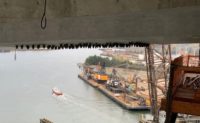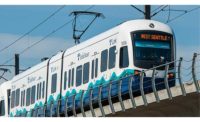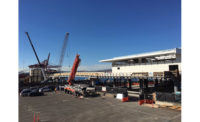West Seattle Bridge Decision Coming This Summer, Tunnel Discussion Starts

After crews drilled precision holes in the concrete of the now-closed West Seattle High-Rise Bridge last weekend to collect core concrete samples to test corrosion resistance, the Seattle Dept. of Transportation expects to determine the bridge’s structural stability in “late June or early July.”
“This information is critical to understanding whether repairs to the bridge are possible,” the agency said in a statement, “and provides important information needed to decide what is best going forward.”
The bridge, which crosses the Duwamish River, was closed due to worsening cracks on March 23. An emergency contract with Kraemer North America will fix a bulging bearing on the bridge’s Pier 18 to see if the 2,600-ft-long, 36-year-old high-rise structure can be saved.
The Pier 18 fix is meant to halt further damage and provide temporary stability, wrote Greg Banks, engineer with consultant WSP, in a memo to the city. “Simultaneously, we continue to collect data and explore future actions to permanently restore the bridge’s integrity.”
Seattle has also put out a request for statement of qualifications for engineers to help the city’s transportation department deliver a partial or full bridge replacement. City documents show that the contract, estimated at $50 million to $150 million, could last for approximately 10 years. An update to the request, though, added the possibility that a replacement could come in the form of a tunnel.
“We continue to write flexibility into all our contracts and plans,” SDOT stated. “Moving forward with this dual-track approach of repair and replacement is critical.”
The city expects stability analysis by early July and hopes to better understand repair or replacement tradeoffs. If repairs are feasible, reopening would likely not happen until and only extend the bridge’s life by 10 years.
Construction on a new crossing could take four to six years, including the public comment and design phases.
No matter the path, Pier 18 work will move forward, along with wrapping the bridge support structure with carbon-fiber reinforcement, installing steel tendons to the inside floor of the bridge and adding shoring.





